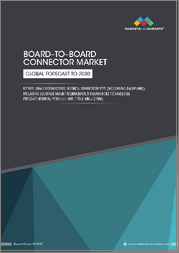
|
시장보고서
상품코드
1410084
세계 PCB 커넥터 시장 예측(2023-2028년)PCB Connector Market - Forecasts from 2023 to 2028 |
||||||
세계 PCB 커넥터 시장은 예측 기간 동안 복합 연간 성장률(CAGR) 5.07%로 성장할 것으로 예측됩니다.
PCB 커넥터에 탑재된 PCB에 장착하면 PCB 간 또는 프린트 보드와 디바이스의 외부 소스 간의 신호 및 전력 전달을 용이하게 합니다. 이러한 커넥터는 부드럽고 중단 없는 연결을 용이하게 하기 위해 매우 중요합니다. PCB 커넥터는 항공우주, 방위, 산업, 전력, 에너지, 자동차, 전기 및 전자 등 광범위한 최종 사용자에게 서비스를 제공합니다. 오토메이션과 로보틱스의 채용이 확대되고 있어 자동차 생산의 활황과 함께 PCB 커넥터 시장의 현저한 촉진요인이 되고 있습니다.
오토메이션과 로봇의 채용 확대가 PCB 커넥터 시장의 성장을 뒷받침.
PCB 커넥터는 다양한 컴포넌트, 모듈, 서브시스템 간의 신호와 전력의 원활한 전송을 가능하게 하고, 자동화 및 로봇의 원활한 통신과 조정을 실현합니다. 생산성 향상, 정밀도 개선, 인건비 절감, 복잡한 작업을 효율적으로 처리하는 능력에 대한 요구가 높아짐이 로봇 공학 도입을 뒷받침하고 PCB 커넥터 수요도 비례하여 급증하고 있다 합니다. 국제로봇연맹에 따르면 세계 로봇 설치 대수는 2021년 51만 7,385대로 과거 최고를 기록해 2020년에 비해 31% 증가했습니다. 또(2022년)의 예상 설치 대수는 57만대가 되고 있습니다.
자동차의 대두가 PCB 커넥터 시장의 확대를 견인
PCB 커넥터는 자동차의 다양한 전자 부품과 시스템을 연결 및 상호 연결하는 데 중요한 역할을 하기 때문에 자동차 업계에서 필수적입니다. 자동차의 전동화, ADAS(첨단 운전 지원 시스템), 전기 자동차의 동향에 따라 PCB 커넥터 수요가 크게 증가하고 있습니다. 국제에너지기구(IEA)에 따르면 2023년 1분기 세계 전기자동차시장은 눈부신 성장을 이루며 230만대 이상의 전기자동차가 판매되어 전년 동기 대비 약 25%의 대폭 증가 .
신재생에너지로의 이동이 PCB 커넥터 시장의 성장을 견인
PCB 커넥터는 태양전지판, 풍력 터빈 및 기타 재생 가능 에너지 설비 내의 다양한 구성 요소와 시스템의 상호 연결에 사용됩니다. 신재생에너지로의 변화 증가와 환경문제에 대한 대처에 대한 정부의 호의적인 이니셔티브가 결합되어 전력 및 에너지 섹터가 확대되고 있어 신재생에너지 시스템 내의 효율적인 송전과 감시를 촉진한다 따라서 PCB 커넥터 시장 수요도 이에 대응하여 자극될 것으로 예상됩니다. 국제재생가능에너지기구(International Renewable Energy Agency)에 따르면, 세계 재생가능에너지 발전용량은 2022년 총 3,372 기가와트(GW)에 이르며 재생가능전력 스톡의 9.6% 증가를 의미합니다.
아시아태평양이 큰 시장 점유율을 차지할 것으로 예상됩니다.
아시아태평양은 중국, 일본, 인도 등 주요 경제국이 전기 자동차 및 로봇 용도에 많은 투자를 하고 있기 때문에 PCB 커넥터 업계를 지배할 것으로 예측되고 있습니다. 이러한 투자는 이 지역의 PCB 커넥터 수요를 촉진하고 있습니다. 2023년 중국 전기자동차(EV) 대형 BYD는 태국에 새로운 제조 시설을 설립하기 위해 179억 바트를 투자할 것이라고 발표했습니다. 이 시설은 2024년 연간 15만대의 승용차 생산에 주력합니다. 또한 인도 정부는 2022년 3월 벵갈루루에 2억 3,000만 루피를 투입해 인공지능 및 로봇기술파크를 설립했습니다. 이 구상은 AI와 로봇 공학의 연구, 혁신, 개발을 추진하는 것을 목적으로 하고 있습니다.
무선 통신의 보급이 PCB 커넥터 시장을 억제하고 있습니다.
PCB 커넥터를 포함한 기존 유선 커넥터에서 점진적으로 이동할 수 있으므로 무선 연결 옵션이 널리 채택되었습니다. 이러한 상황 변화로 인해 PCB 커넥터 제조업체는 시장의 진화하는 연결 요구 사항을 충족하고 관련성을 유지하기 위해 적응하고 혁신해야 할 필요성을 강조합니다. 예를 들어 실리콘 랩은 2022년 9월 2.4GHz 무선 기능을 갖춘 BGM240P 및 MGM240P PCB 모듈을 발표하여 IoT 디바이스 제조업체에게 개발 프로세스의 가속화와 간소화를 제공했습니다. 이러한 모듈은 개발을 가속화하고 간소화하여 IoT 장비 제조업체가 보다 효율적으로 제품을 개발할 수 있도록 합니다.
당사 제품
- FFC 커넥터: TE 커넥티비티는 케이블 스트립이나 도금 공정 생략과 같은 몇 가지 장점을 제공하는 FFC 커넥터를 제공합니다. 이 커넥터는 여러 개의 크림프 접점을 신속하고 순차적으로 적용할 수 있어 효율적이고 신뢰할 수 있는 연결을 보장합니다. 또한 FFC 케이블 접점과 원형 접점을 혼합할 수 있으므로 설계 및 조립 옵션에 유연성이 추가됩니다. TE Connectivity의 FFC 커넥터를 통해 고객은 간소화된 제조 공정, 향상된 성능 및 용도 설계 범용성을 향상시킬 수 있습니다.
- MSTBVA 2,5/4-G-5,08: Phoenix Contact는 웨이브 솔더 실장 유형을 특징으로 하는 MSTBVA 2,5 / 4-G-5,08 커넥터를 제공합니다. 총 4개의 연결에서 이 커넥터는 선형 피닝 레이아웃을 제공합니다. MSTBVA 2,5/4-G-5,08은 조립 공정을 간소화하도록 설계되었으며 효율적이고 안정적인 연결이 가능합니다. 피닉스 컨택트의 이 커넥터는 웨이브 납땜이 선호되는 구현 방법인 다양한 용도에 적합하며, 전자 어셈블리에 편의성과 사용 편의성을 제공합니다.
- 마이크로 HDAS Amphenol Corporation은 작고 가벼운 폼 팩터를 제공하는 견고한 PCB 커넥터인 Micro HDAS를 발표합니다. 다양한 접점 및 피팅 옵션을 제공하여 다양한 사용자 정의를 가능하게 합니다. Micro HDAS 커넥터는 보드 간격 단 7.4mm의 소형 메자닌 연결을 가능하게 합니다. 견고한 설계, 다양한 구성 옵션 및 공간 절약 기능으로 암페놀의 Micro HDAS 커넥터는 다양한 용도에 안정적인 연결 솔루션을 제공합니다.
목차
제1장 서론
- 시장 개요
- 시장의 정의
- 조사 범위
- 시장 세분화
- 통화
- 전제조건
- 기준년과 예측년의 타임라인
제2장 조사 방법
- 조사 데이터
- 전제조건
제3장 주요 요약
- 조사 하이라이트
제4장 시장 역학
- 시장 성장 촉진요인
- 시장 성장 억제요인
- Porter's Five Forces 분석
- 업계 밸류체인 분석
제5장 PCB 커넥터 시장 : 유형별
- 소개
- 핀 헤더 커넥터
- 기판 대 기판 커넥터
- 와이어 대 기판
- USB 커넥터
- 기타
제6장 PCB 커넥터 시장 : 재료별
- 소개
- 금속
- 구리
- 알루미늄
- 철
- 폴리테트라플루오로에틸렌(PTFE)
- 기타
제7장 PCB 커넥터 시장 : 최종 사용자별
- 소개
- 항공우주 및 방위
- 산업용
- 전력 및 에너지
- 자동차
- 전기 및 전자
- 기타
제8장 PCB 커넥터 시장 : 지역별
- 소개
- 북미
- 미국
- 캐나다
- 멕시코
- 남미
- 브라질
- 아르헨티나
- 기타
- 유럽
- 독일
- 영국
- 프랑스
- 스페인
- 기타
- 중동 및 아프리카
- 사우디아라비아
- 아랍에미리트(UAE)
- 기타
- 아시아태평양
- 중국
- 일본
- 한국
- 인도
- 호주
- 기타
제9장 경쟁 환경과 분석
- 주요 기업과 전략 분석
- 신흥기업과 시장수익성
- 합병, 인수, 합의 및 협업
- 벤더 경쟁 매트릭스
제10장 기업 프로파일
- TE Connectivity
- Phoenix Contact
- Amphenol Corporation
- HARTING Stiftung & Co KG.
- Smiths Interconnect (Smiths Group)
- Molex LLC(Koch Industries)
- GCT(Aloco Group)
- 3M
- Harwin
- Vital Electrocomp
The global PCB connector market is estimated to grow at a CAGR of 5.07% during the forecast period.
PCB connectors, mounted on the printed circuit board, facilitate the transfer of signals or power between PCBs or between the PCB and external sources within a device. These connectors are crucial for facilitating smooth and uninterrupted connectivity. PCB connectors serve a wide range of end users including aerospace and defense, industrial, power and energy, automotive, and electrical and electronics. The growing adoption of automation and robotics, coupled with the booming automotive production serves as prominent drivers for the PCB connector market.
Growing automation and robotics adoption bolsters the PCB connector market growth.
PCB connectors enable the seamless transmission of signals and power between various components, modules, and subsystems, ensuring smooth communication and coordination in automation and robots. The increasing need for enhanced productivity, improved precision, reduced labour costs, and the ability to handle complex tasks efficiently has propelled robotics installation which is booming the demand for PCB connectors proportionally. According to the International Federation of Robotics, global robot installations reached a record high of 517,385 units in 2021, growing by 31% compared to 2020. Also, as per the source anticipated installation for 2022 stood at 570,000.
Emerging automotive drives the PCB connector market expansion.
PCB connectors are essential in the automotive industry as they play a crucial role in connecting and interconnecting various electronic components and systems within vehicles. With the growing trend of automotive electrification, advanced driver-assistance systems (ADAS), and electric vehicles, the demand for PCB connectors has significantly increased. According to the International Energy Agency, in the first quarter of 2023, the global electric car market witnessed remarkable growth, with over 2.3 million electric cars sold, representing a significant increase of approximately 25% compared to the same period in the previous year.
Shift toward renewable energy drives PCB connector market growth.
PCB connectors are utilized for interconnecting various components and systems within solar panels, wind turbines, and other renewable energy installations. The growing shift towards renewable energy coupled with favourable government initiatives to tackle environmental concerns is expanding the power & energy sector which is expected to stimulate PCB connector's market demand correspondingly, as they facilitate efficient power transmission and monitoring within renewable energy systems. According to the International Renewable Energy Agency, the global renewable generation capacity reached a total of 3,372 gigawatts (GW) in 2022 which signified a 9.6% increase in the stock of renewable power.
Asia-Pacific is expected to account for a major market share.
Asia-Pacific is projected to dominate the PCB connector industry owing to the significant investments made by leading economies namely China, Japan, and India in electric vehicle and robotics applications. These investments have propelled the demand for PCB connectors in the region. In 2023, Chinese electric vehicle (EV) leader BYD announced its investment of 17.9 billion baht to establish a new manufacturing facility in Thailand. The facility will focus on producing 150,000 passenger cars annually in 2024. Also, in March 2022, the Indian government, launched the Artificial Intelligence and Robotics Technology Park in Bengaluru, with an initial investment of Rs 230 crore. This initiative aims to drive research, innovation, and development in AI and robotics.
The increasing adoption of wireless communication restrains the PCB connector market.
Wireless connectivity options are being widely adopted owing to which there is a possibility of a gradual shift away from traditional wired connectors, including PCB connectors. This changing landscape emphasizes the need for PCB connector manufacturers to adapt and innovate to remain relevant and address the evolving connectivity requirements of the market. For instance, in September 2022, Silicon Labs introduced the BGM240P and MGM240P PCB modules, featuring 2.4 GHz wireless capabilities, to provide IoT device manufacturers with accelerated and streamlined development processes. These modules bring about faster and simplified development, empowering IoT device makers to create their products more efficiently.
Key Developments
- December 2021: Phoenix Contact introduced a new range of connectors for PCB terminals, offering a diverse selection of sizes ranging from 2.5 mm to 20 mm pitch. These connectors are capable of handling high ratings up to 232A and 1000V, ensuring reliable and efficient power transmission. With a wide array of connection technologies available, including screw, spring-cage, crimp, and insulation displacement, these connectors provide flexibility and versatility to meet various application requirements.
- June 2020: TE Connectivity (TE), a global leader in connectivity and sensors, introduced the D-2970 Dynamic Series compact wire-to-board PCB connector featuring a field-installable push-in clamp termination mechanism, offering a time-saving solution. This innovative connector allows for efficient and reliable wire-to-board connections, providing convenience and flexibility for various applications. With its compact design and user-friendly installation, the D-2970 Dynamic Series connector enhances productivity and simplifies the assembly process in PCB applications.
Company Products
- FFC Connectors: TE Connectivity offers FFC connectors that provide several advantages, including the elimination of cable stripping and plating processes. These connectors facilitate high-speed sequential application of multiple-crimp contacts, ensuring efficient and reliable connections. Additionally, the capability of intermixing FFC cable and round wire contacts adds flexibility to design and assembly options. With TE Connectivity's FFC connectors, customers can enjoy streamlined manufacturing processes, enhanced performance, and increased design versatility for their applications.
- MSTBVA 2,5/ 4-G-5,08: Phoenix Contact offers the MSTBVA 2,5/4-G-5,08 connector, featuring a wave soldering mounting type. With a total of four connections, this connector provides a linear pinning layout. The MSTBVA 2,5/4-G-5,08 is designed to simplify the assembly process, allowing for efficient and reliable connections. This connector from Phoenix Contact is suitable for various applications where wave soldering is the preferred method of mounting, providing convenience and ease of use in electronic assemblies.
- Micro HDAS: Amphenol Corporation presents the Micro HDAS, a rugged PCB connector that offers a smaller and lighter form factor. It provides a wide range of contact and fittings options, allowing for versatile customization. The Micro HDAS connector enables a compact mezzanine connection, with a mere 7.4 mm spacing between boards. With its robust design, diverse configuration choices, and space-saving capabilities, the Micro HDAS connector from Amphenol Corporation delivers reliable connectivity solutions for various applications.
Segmentation
By Type
- Pin Header Connector
- Board-To-Board Connector
- Wire-To-Board
- USB Connector
- Others
By Material
- Metal
- Copper
- Aluminum
- Iron
- Polytetrafluroethylene (PTFE)
- Others
By End-Users
- Aerospace & Defense
- Industrial
- Power & Energy
- Automotive
- Electrical & Electronics
- Others
By Geography
- North America
- USA
- Canada
- Mexico
- South America
- Brazil
- Argentina
- Others
- Europe
- Germany
- UK
- France
- Spain
- Others
- Middle East and Africa
- Saudi Arabia
- UAE
- Others
- Asia Pacific
- China
- Japan
- South Korea
- India
- Australia
- Other
TABLE OF CONTENTS
1. INTRODUCTION
- 1.1. Market Overview
- 1.2. Market Definition
- 1.3. Scope of the Study
- 1.4. Market Segmentation
- 1.5. Currency
- 1.6. Assumptions
- 1.7. Base, and Forecast Years Timeline
2. RESEARCH METHODOLOGY
- 2.1. Research Data
- 2.2. Assumptions
3. EXECUTIVE SUMMARY
- 3.1. Research Highlights
4. MARKET DYNAMICS
- 4.1. Market Drivers
- 4.2. Market Restraints
- 4.3. Porter's Five Force Analysis
- 4.3.1. Bargaining Power of Suppliers
- 4.3.2. Bargaining Power of Buyers
- 4.3.3. Threat of New Entrants
- 4.3.4. Threat of Substitutes
- 4.3.5. Competitive Rivalry in the Industry
- 4.4. Industry Value Chain Analysis
5. PCB CONNECTOR MARKET ANALYSIS, BY TYPE
- 5.1. Introduction
- 5.2. Pin Header Connector
- 5.3. Board-To-Board Connector
- 5.4. Wire-To-Board
- 5.5. USB Connector
- 5.6. Others
6. PCB CONNECTOR MARKET ANALYSIS, BY MATERIAL
- 6.1. Introduction
- 6.2. Metal
- 6.2.1. Copper
- 6.2.2. Aluminum
- 6.2.3. Iron
- 6.3. Polytetrafluoroethylene (PTFE)
- 6.4. Others
7. PCB CONNECTOR MARKET ANALYSIS, BY END-USERS
- 7.1. Introduction
- 7.2. Aerospace & Defense
- 7.3. Industrial
- 7.4. Power & Energy
- 7.5. Automotive
- 7.6. Electrical & Electronics
- 7.7. Others
8. PCB CONNECTOR MARKET ANALYSIS, BY GEOGRAPHY
- 8.1. Introduction
- 8.2. North America
- 8.2.1. USA
- 8.2.2. Canada
- 8.2.3. Mexico
- 8.3. South America
- 8.3.1. Brazil
- 8.3.2. Argentina
- 8.3.3. Others
- 8.4. Europe
- 8.4.1. Germany
- 8.4.2. UK
- 8.4.3. France
- 8.4.4. Spain
- 8.4.5. Others
- 8.5. Middle East and Africa
- 8.5.1. Saudi Arabia
- 8.5.2. UAE
- 8.5.3. Others
- 8.6. Asia Pacific
- 8.6.1. China
- 8.6.2. Japan
- 8.6.3. South Korea
- 8.6.4. India
- 8.6.5. Australia
- 8.6.6. Others
9. COMPETITIVE ENVIRONMENT AND ANALYSIS
- 9.1. Major Players and Strategy Analysis
- 9.2. Emerging Players and Market Lucrativeness
- 9.3. Mergers, Acquisitions, Agreements, and Collaborations
- 9.4. Vendor Competitiveness Matrix
10. COMPANY PROFILES
- 10.1. TE Connectivity
- 10.2. Phoenix Contact
- 10.3. Amphenol Corporation
- 10.4. HARTING Stiftung & Co KG.
- 10.5. Smiths Interconnect (Smiths Group)
- 10.6. Molex LLC (Koch Industries)
- 10.7. GCT (Aloco Group)
- 10.8. 3M
- 10.9. Harwin
- 10.10. Vital Electrocomp



















